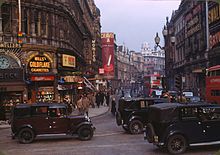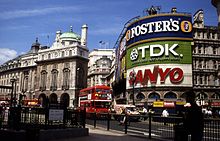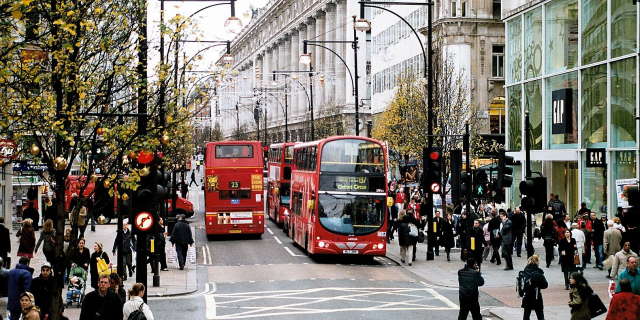Piccadilly Circus
Piccadilly Circus is a road junction and public space of London's West End in the City of Westminster. It was built in 1819 to connect Regent Street with Piccadilly. In this context, a circus, from the Latin word meaning "circle", is a round open space at a street junction.
The Circus now connects Piccadilly, Regent Street, Shaftesbury Avenue, the Haymarket, Coventry Street (onwards to Leicester Square) and Glasshouse Street. It is close to major shopping and entertainment areas in the West End. Its status as a major traffic junction has made Piccadilly Circus a busy meeting place and a tourist attraction in its own right. The Circus is particularly known for its video display and neon signs mounted on the corner building on the northern side, as well as the Shaftesbury Memorial Fountain and statue of Anteros (which is popularly, though mistakenly, ...Read more
Piccadilly Circus is a road junction and public space of London's West End in the City of Westminster. It was built in 1819 to connect Regent Street with Piccadilly. In this context, a circus, from the Latin word meaning "circle", is a round open space at a street junction.
The Circus now connects Piccadilly, Regent Street, Shaftesbury Avenue, the Haymarket, Coventry Street (onwards to Leicester Square) and Glasshouse Street. It is close to major shopping and entertainment areas in the West End. Its status as a major traffic junction has made Piccadilly Circus a busy meeting place and a tourist attraction in its own right. The Circus is particularly known for its video display and neon signs mounted on the corner building on the northern side, as well as the Shaftesbury Memorial Fountain and statue of Anteros (which is popularly, though mistakenly, believed to be of Eros).
It is surrounded by several notable buildings, including the London Pavilion and Criterion Theatre. Underneath the plaza is Piccadilly Circus Underground station, part of the London Underground system.
 Piccadilly Circus in 1896, with a view towards Leicester Square via Coventry Street. London Pavilion is on the left, and Criterion Theatre on the right.
Piccadilly Circus in 1896, with a view towards Leicester Square via Coventry Street. London Pavilion is on the left, and Criterion Theatre on the right. London's Piccadilly Circus in 1908.[1] On the left is the old County Fire Office.
London's Piccadilly Circus in 1908.[1] On the left is the old County Fire Office. Piccadilly Circus in 1949
Piccadilly Circus in 1949 Piccadilly Circus in 1962
Piccadilly Circus in 1962 Piccadilly Circus in 1970
Piccadilly Circus in 1970 Signs in 1992
Signs in 1992Piccadilly Circus connects to Piccadilly, a thoroughfare whose name first appeared in 1626 as Piccadilly Hall, named after a house belonging to one Robert Baker, a tailor famous for selling piccadills, or piccadillies, a term used for various kinds of collars. The street was known as Portugal Street in 1692 in honour of Catherine of Braganza, the queen consort of King Charles II but was known as Piccadilly by 1743. Piccadilly Circus was created in 1819, at the junction with Regent Street, which was then being built under the planning of John Nash on the site of a house and garden belonging to a Lady Hutton; the intersection was then known as Regent Circus South (just as Oxford Circus was known as Regent Circus North) and it did not begin to be known as Piccadilly Circus until the mid 1880s, with the rebuilding of the Regent Street Quadrant and the construction of Shaftesbury Avenue. In the same period the circus lost its circular form.[2]
 Traffic at Piccadilly Circus
Traffic at Piccadilly CircusThe junction has been a very busy traffic interchange since construction, as it lies at the centre of Theatreland and handles exit traffic from Piccadilly, which Charles Dickens Jr. described in 1879: "Piccadilly, the great thoroughfare leading from the Haymarket and Regent-street westward to Hyde Park-corner, is the nearest approach to the Parisian boulevard of which London can boast."
Piccadilly Circus tube station was opened on 10 March 1906, on the Bakerloo line, and on the Piccadilly line in December of that year. In 1928, the station was extensively rebuilt to handle an increase in traffic. The junction's first electric advertisements appeared in 1910, and, from 1923, electric billboards were set up on the facade of the London Pavilion. Electric street lamps, however, did not replace the gas ones until 1932.[3] The circus became a one-way roundabout on 19 July 1926.[4] Traffic lights were first installed on 3 August 1926.
During World War II many servicemen's clubs in the West End served American soldiers based in Britain. So many prostitutes roamed the area approaching the soldiers that they received the nickname "Piccadilly Commandos", and both Scotland Yard and the Foreign Office discussed possible damage to Anglo-American relations.[5]
At the start of the 1960s, it was determined that the Circus needed to be redeveloped to allow for greater traffic flow. In 1962, Lord Holford presented a plan which would have created a "double-decker" Piccadilly Circus; the upper deck would have been an elevated pedestrian concourse linking the buildings around the perimeter of the Circus, with the lower deck being solely for traffic, most of the ground-level pedestrian areas having been removed to allow for greater vehicle flow. This concept was kept alive throughout the rest of the 1960s. A final scheme in 1972 proposed three octagonal towers (the highest 240 feet (73 m) tall) to replace the Trocadero, the Criterion and the "Monico" buildings.[6] The plans were permanently rejected by Sir Keith Joseph and Ernest Marples; the key reason given was that Holford's scheme only allowed for a 20% increase in traffic, and the Government required 50%.
The Holford plan is referenced in the short-form documentary film "Goodbye, Piccadilly", produced by the Rank Organisation in 1967 as part of their Look at Life series when it was still seriously expected that Holford's recommendations would be acted upon. Piccadilly Circus has since escaped major redevelopment, apart from extensive ground-level pedestrianisation around its south side in the 1980s.
The Circus has been targeted by Irish republican terrorists multiple times. On 24 June 1939 an explosion occurred, although no injuries were caused.[7] On 25 November 1974 a bomb injured 16 people.[8] A 2 lb bomb exploded on 6 October 1992, injuring five people.[9]
The Shaftesbury Memorial Fountain at Piccadilly Circus was erected in 1893 to commemorate the philanthropic works of Anthony Ashley Cooper, 7th Earl of Shaftesbury. It was removed from the Circus twice and moved from the centre once. The first time was in 1922, so that Charles Holden's new tube station could be built directly below it. The fountain returned in 1931. During the Second World War, the fountain was removed for the second time and replaced by advertising hoardings. It was returned again in 1948. When the Circus underwent reconstruction work in the late 1980s, the entire fountain was moved from the centre of the junction at the beginning of Shaftesbury Avenue to its present position at the southwestern corner.[10]







































Add new comment